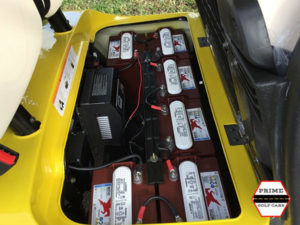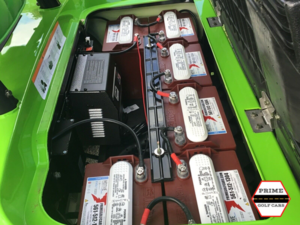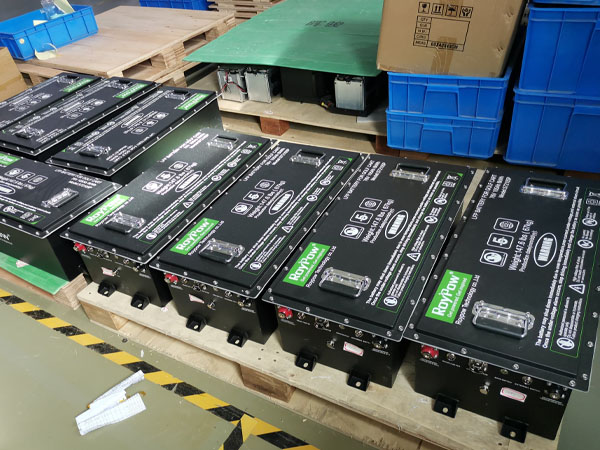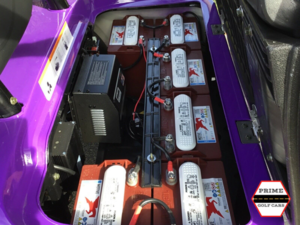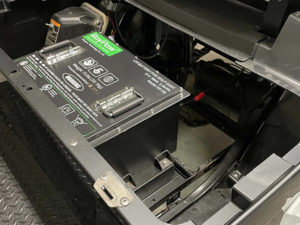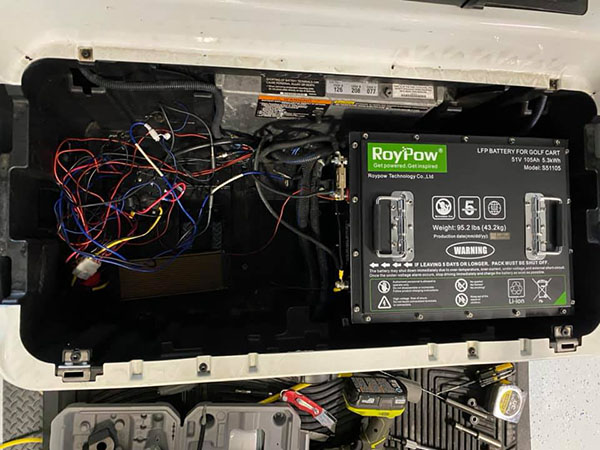Recently, we began stocking a new, affordable 50AH lithium battery kit for golf carts, which includes everything needed to convert a 48V golf cart from a lead-acid battery system to a lithium battery. The 50AH lithium battery kit comes with the battery, charger, adaptor, and mounting brackets for your specific golf cart. Like all other golf cart lithium batteries, this battery is universal and can be installed in any golf cart, including popular brands such as EZGO, Club Car, and Yamaha, and more specific brands like Advanced EV, Bintelli, and America EV. To learn more about the benefits of switching to a lithium battery, check out our blog where we go over all the potential advantages of switching from lead-acid to lithium. Benefits include no maintenance – such as waterfilling or terminal cleaning -, much less weight on the golf cart, a longer battery lifespan, faster charging time, a longer driving range, and many more.
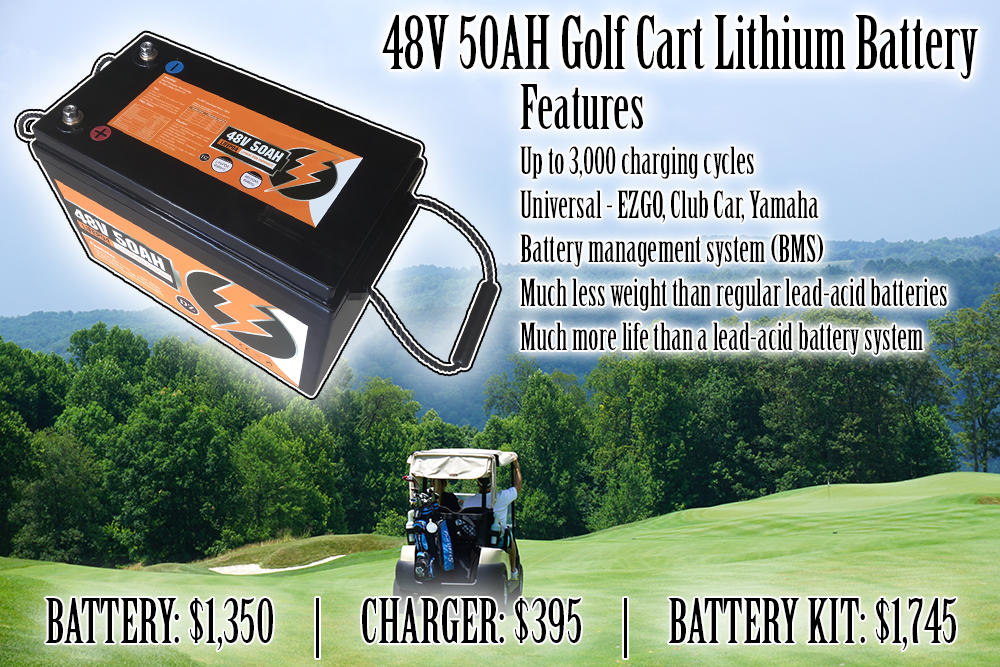
To read more about the 50AH lithium battery, check out our page with more details, and to order, visit our golf cart accessories and parts website, Prime Cart Parts.
50AH Lithium Battery Specifications
Large Capacity and Lightweight
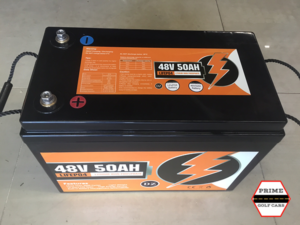 Fully charged 48V 50ah LiFePO4 Lithium Battery can support 2560Wh energy for your appliances. It weighs only 40.3 lbs, only 1/3 of the weight of a 12V 100Ah AGM SLA Battery. It makes installation and movement more easier.
Fully charged 48V 50ah LiFePO4 Lithium Battery can support 2560Wh energy for your appliances. It weighs only 40.3 lbs, only 1/3 of the weight of a 12V 100Ah AGM SLA Battery. It makes installation and movement more easier.
Long Life Cycle
Grade A LiFePO4 Cells makes the 50Ah battery more stable and greater, and the lithium rechargeable battery cycles more than 3,000 times, which is more than 4 times comparing with Lead-acid batteries. Our lithium-iron batteries can maintain 80% capacity after 3,000 deep cycles.
BMS High-Efficiency Protection
The lithium iron phosphate battery has an excellent BMS (Battery Management System) function, which can prevent its overvoltage or undervoltage, overcurrent, high temperature or short circuit.
Fast Charging
This lithium battery can be recharged from 0% TO 80% within 3-4 hrs. And can be used in parallel, more suitable for 48V solar panel kit, less wires, less heat loss and less balance issue.
50AH Lithium Battery Prices
 Full battery kit – $1,745
Full battery kit – $1,745
Only battery – $1,350
Only charger – $395
Other Golf Cart Lithium Batteries
We carry multiple brands of golf cart lithium battery, all universal and fitting in all brands of golf cart. These include the Roy Pow 56AH lithium battery, Roy Pow 100AH lithium battery, and Roy Pow 160AH lithium battery. We have the Allied 65AH lithium battery and Allied 105AH lithium battery, and we also carry the ProVolt 105AH lithium battery and ProVolt 176AH lithium battery.
|
Roy Pow Lithium Battery |
Allied Lithium Battery |
ProVolt Lithium Battery |
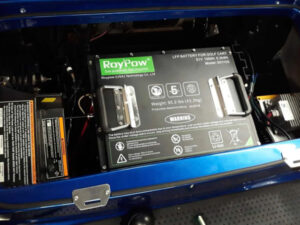 |
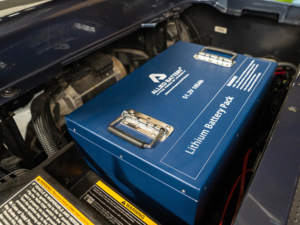 |
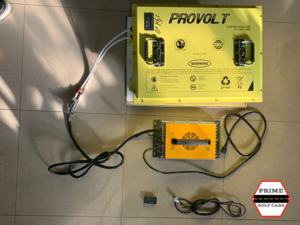 |
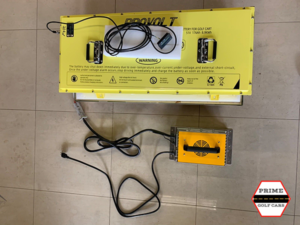
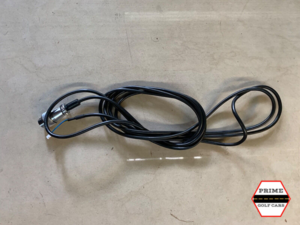
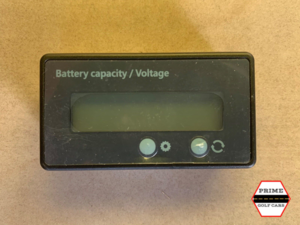
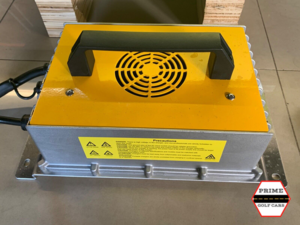
 A DPI brand charger with EZGO SB-50 2-pin connector. Designed to be used on any 36 volt golf cart that uses the 2 blade SB-50 connector and charging port.
A DPI brand charger with EZGO SB-50 2-pin connector. Designed to be used on any 36 volt golf cart that uses the 2 blade SB-50 connector and charging port.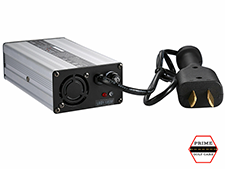 36 Volt charger for EZGO TXT, Club Car DS, and Yamaha golf carts, with crow’s foot connector. This is an automatic charger with a trickle mode that makes sure your batteries are not overcharged, which keeps them running stronger for longer. It is designed to turn off when the voltage reaches a certain level. Charging time is usually between 4-6 hours.
36 Volt charger for EZGO TXT, Club Car DS, and Yamaha golf carts, with crow’s foot connector. This is an automatic charger with a trickle mode that makes sure your batteries are not overcharged, which keeps them running stronger for longer. It is designed to turn off when the voltage reaches a certain level. Charging time is usually between 4-6 hours.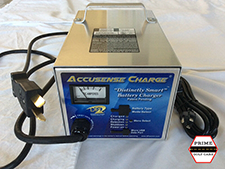 DPI brand 36 volt charger with a crow’s foot connector, for EZGO, Club Car, and Yamaha golf carts.
DPI brand 36 volt charger with a crow’s foot connector, for EZGO, Club Car, and Yamaha golf carts.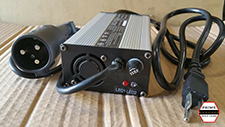 Fully automatic 48 Volt battery charger for Star golf carts. Comes pre-configured with a 48V style connector plug. Operates on standard household power. Made for overnight charging and features a trickle mode. 2 LED lights indicate charging status.
Fully automatic 48 Volt battery charger for Star golf carts. Comes pre-configured with a 48V style connector plug. Operates on standard household power. Made for overnight charging and features a trickle mode. 2 LED lights indicate charging status.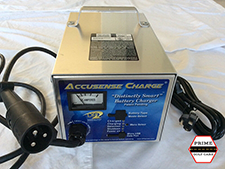 DPI brand 48 volt Star golf cart charger with Star 3-pin connector. Designed to be used on any 48 volt Star golf cart that uses the Star 3-pin connector and charging port. No spark charging; reverse battery protection.
DPI brand 48 volt Star golf cart charger with Star 3-pin connector. Designed to be used on any 48 volt Star golf cart that uses the Star 3-pin connector and charging port. No spark charging; reverse battery protection.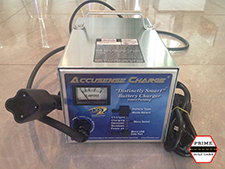 48 volt Yamaha golf cart DPI brand charger for the Yamaha Drive or G29 from 2007 and up. Designed to be used on any 48 volt Yamaha golf cart that uses the Yamaha 3-pin connector and charging port.
48 volt Yamaha golf cart DPI brand charger for the Yamaha Drive or G29 from 2007 and up. Designed to be used on any 48 volt Yamaha golf cart that uses the Yamaha 3-pin connector and charging port.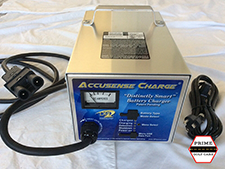 DPI brand 48 volt Yamaha G19 G22 golf cart charger with Yamaha 2-pin connector. Designed to be used on any 48 volt Yamaha golf cart that uses the Yamaha 2-pin connector and charging port.
DPI brand 48 volt Yamaha G19 G22 golf cart charger with Yamaha 2-pin connector. Designed to be used on any 48 volt Yamaha golf cart that uses the Yamaha 2-pin connector and charging port. 48 volt charger pre-configured with a Yamaha Nabson style connector plug. Made for overnight charging. Includes automatic LED charging status lights.
48 volt charger pre-configured with a Yamaha Nabson style connector plug. Made for overnight charging. Includes automatic LED charging status lights.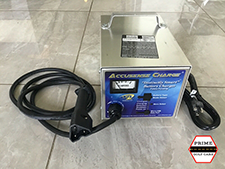 48 volt DPI brand charger for EZGO TXT RXV golf carts. Designed to be used on any 48 volt EZGO TXT golf cart that uses the EZGO 3-Pin Connector and charging port.
48 volt DPI brand charger for EZGO TXT RXV golf carts. Designed to be used on any 48 volt EZGO TXT golf cart that uses the EZGO 3-Pin Connector and charging port. New DPI brand 48 volt Club Car DS/Club Car Precedent golf cart charger. Works with 1996 or newer models. Factory sealed box.
New DPI brand 48 volt Club Car DS/Club Car Precedent golf cart charger. Works with 1996 or newer models. Factory sealed box.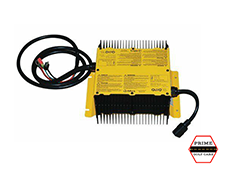 Delta Q QuiQ On-board 48 volt battery charger for golf carts with wet or sealed batteries. Completely sealed, the Delta Q golf cart charger is passively cooled without the use of fans, and can store up to user-selectable charge algorithms.
Delta Q QuiQ On-board 48 volt battery charger for golf carts with wet or sealed batteries. Completely sealed, the Delta Q golf cart charger is passively cooled without the use of fans, and can store up to user-selectable charge algorithms.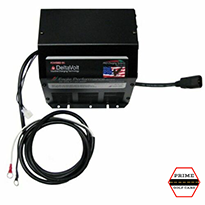 For any heavy duty 48 volt system, the Eagle is set up to charge efficiently and reliably every time. The charger has an integrated microprocessor to prevent overcharging the battery system, turning off completely once the batteries are fully charged. If batteries drop below a programmed voltage amount, the Eagle charger automatically reactivates to bring the batteries back to 100%, and can also adjust using an algorithm to compensate for temperature.
For any heavy duty 48 volt system, the Eagle is set up to charge efficiently and reliably every time. The charger has an integrated microprocessor to prevent overcharging the battery system, turning off completely once the batteries are fully charged. If batteries drop below a programmed voltage amount, the Eagle charger automatically reactivates to bring the batteries back to 100%, and can also adjust using an algorithm to compensate for temperature.